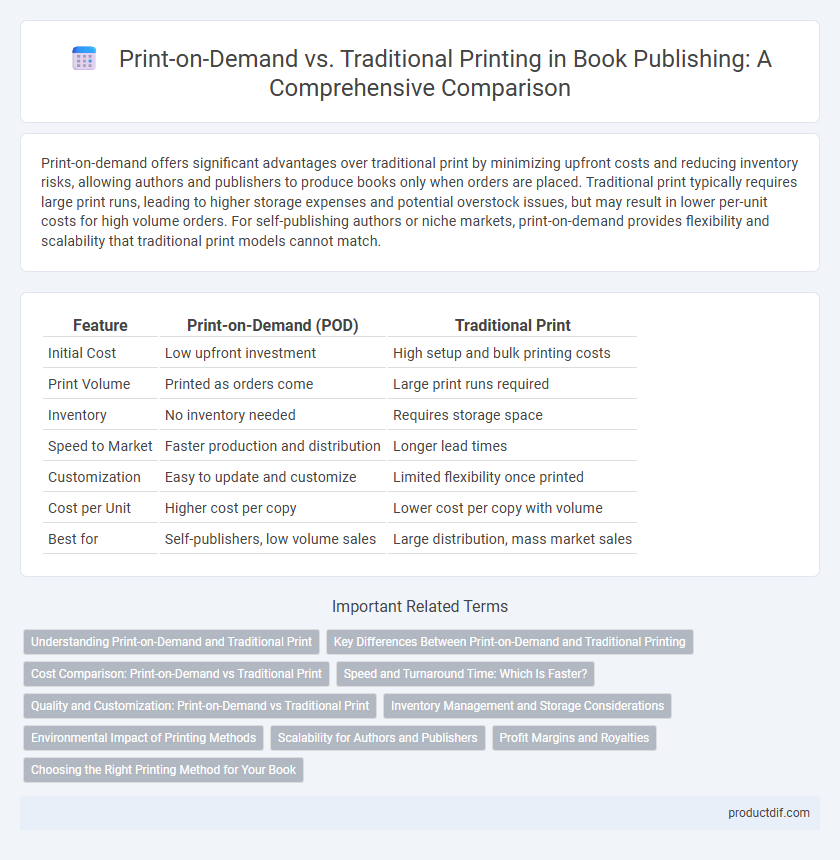Print-on-demand offers significant advantages over traditional print by minimizing upfront costs and reducing inventory risks, allowing authors and publishers to produce books only when orders are placed. Traditional print typically requires large print runs, leading to higher storage expenses and potential overstock issues, but may result in lower per-unit costs for high volume orders. For self-publishing authors or niche markets, print-on-demand provides flexibility and scalability that traditional print models cannot match.
Table of Comparison
| Feature | Print-on-Demand (POD) | Traditional Print |
|---|---|---|
| Initial Cost | Low upfront investment | High setup and bulk printing costs |
| Print Volume | Printed as orders come | Large print runs required |
| Inventory | No inventory needed | Requires storage space |
| Speed to Market | Faster production and distribution | Longer lead times |
| Customization | Easy to update and customize | Limited flexibility once printed |
| Cost per Unit | Higher cost per copy | Lower cost per copy with volume |
| Best for | Self-publishers, low volume sales | Large distribution, mass market sales |
Understanding Print-on-Demand and Traditional Print
Print-on-demand (POD) allows authors to publish books with minimal upfront costs by printing copies only when orders are placed, reducing inventory and waste. Traditional print involves large print runs with significant initial investment, offering lower per-unit costs but higher financial risk and storage needs. Understanding the trade-offs between POD's flexibility and traditional print's economies of scale is crucial for authors and publishers aiming for efficient distribution and profitability.
Key Differences Between Print-on-Demand and Traditional Printing
Print-on-Demand (POD) leverages digital technology to produce books only when an order is placed, eliminating the need for large upfront inventory and reducing storage costs. Traditional printing involves mass production with significant initial investment, often requiring authors to predict demand and manage substantial stock. POD allows for faster turnaround times and offers flexibility with print runs, whereas traditional printing typically delivers higher quality and unit cost efficiency for large volumes.
Cost Comparison: Print-on-Demand vs Traditional Print
Print-on-Demand (POD) significantly reduces upfront costs by eliminating large print runs, making it ideal for authors with limited budgets or uncertain demand. Traditional printing requires substantial initial investment for bulk orders, often ranging from hundreds to thousands of copies, leading to higher inventory and storage expenses. POD's per-unit cost is higher but offers cost efficiency by minimizing waste and financial risk compared to traditional print's economies of scale.
Speed and Turnaround Time: Which Is Faster?
Print-on-demand offers significantly faster turnaround times by producing books only after an order is placed, often delivering within days. Traditional print requires lengthy setup processes including plate creation and large batch production, leading to weeks or months before delivery. For authors and publishers seeking rapid distribution, print-on-demand provides a more efficient and scalable solution.
Quality and Customization: Print-on-Demand vs Traditional Print
Print-on-Demand (POD) technology allows for high-quality book production with precise customization options, including variable cover designs and personalized content. Traditional print methods often deliver superior print resolution and color consistency for large print runs but lack the flexibility for individual customization. Comparing both, POD excels in cost-effectiveness and adaptability for small orders, while traditional print remains advantageous for bulk orders requiring uniform quality.
Inventory Management and Storage Considerations
Print-on-Demand (POD) eliminates the need for large inventory storage, reducing warehousing costs and minimizing the risk of unsold stock. Traditional print requires bulk printing and substantial storage space, leading to higher upfront investment and potential inventory surplus. Efficient inventory management in POD enables publishers and authors to fulfill orders dynamically, optimizing cash flow and reducing waste.
Environmental Impact of Printing Methods
Print-on-demand significantly reduces paper waste and carbon emissions by printing only required copies, unlike traditional print runs that often result in surplus inventory and unsold books discarded or recycled. Traditional printing consumes large amounts of energy and chemicals during mass production, contributing to deforestation and pollution. Embracing print-on-demand technology supports sustainable publishing by minimizing resource consumption and lowering the environmental footprint associated with book production.
Scalability for Authors and Publishers
Print-on-demand offers unparalleled scalability for authors and publishers by enabling books to be printed only when ordered, eliminating the need for large upfront inventory investments. Traditional print requires significant capital for bulk printing and storage, limiting scalability and increasing financial risk. Print-on-demand platforms provide flexible production that can easily adjust to demand spikes or niche markets, supporting growth without the constraints of traditional print runs.
Profit Margins and Royalties
Print-on-demand eliminates inventory costs, offering higher profit margins per book sold compared to traditional print, which requires upfront investment in bulk printing. Traditional print royalties average between 5-15% of the retail price, while print-on-demand royalties can reach up to 20%, enhancing earnings for authors. However, print-on-demand unit costs are higher, slightly reducing overall profitability despite increased royalty percentages.
Choosing the Right Printing Method for Your Book
Print-on-demand offers cost-effective, low-risk printing with minimal upfront investment, making it ideal for self-published authors and small print runs. Traditional print provides superior print quality and lower per-unit costs for large volumes, suitable for established authors and publishers targeting widespread distribution. Evaluating factors such as budget, print volume, turnaround time, and distribution goals is crucial when choosing the optimal printing method for your book.
Print-on-Demand vs Traditional Print Infographic

 productdif.com
productdif.com